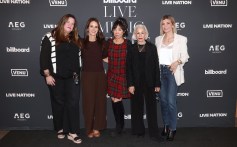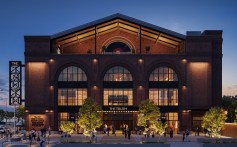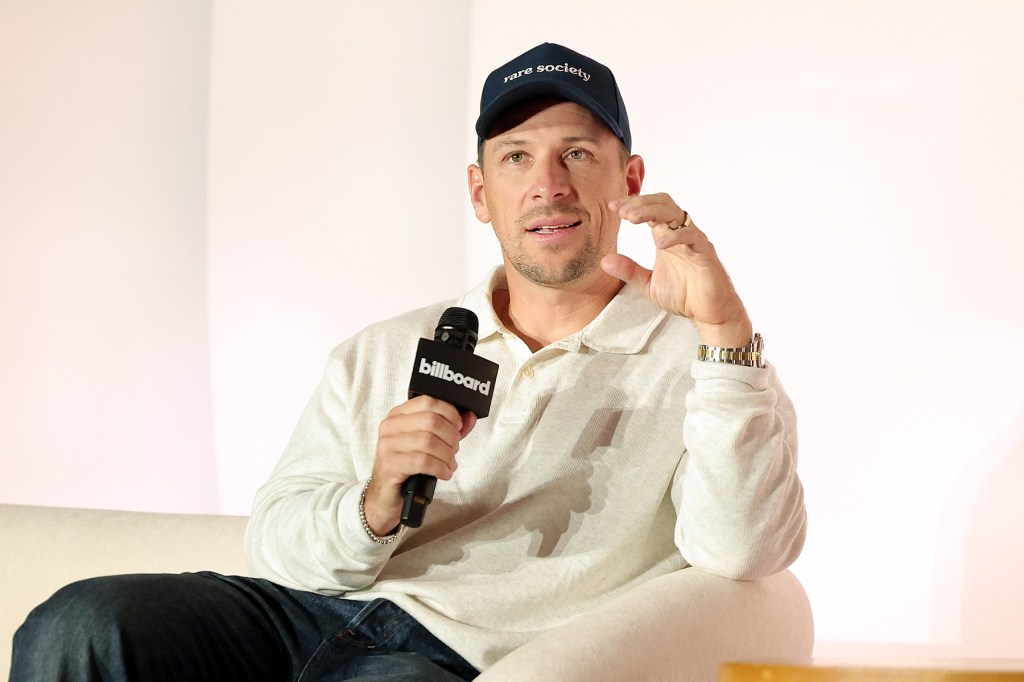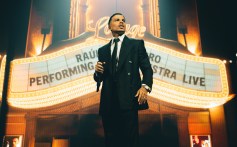Touring
Page: 6
Trending on Billboard
MELBOURNE, Australia — Oasis won’t look back in anger at their first visit to Australia in two decades.
The Britpop era superstars on Tuesday, Nov. 4 wrapped up the Melbourne leg of their swing down under, a three-concert stand at Marvel Stadium which produced three sellouts, playing to 180,000 fans, reps say.
The rock ‘n’ roll stars have made themselves at home, and made their feeling clear on dodgy ticket resales, which didn’t materialize due to the state of Victoria’s tough anti-touting laws.
Related
Under those rules, tickets can’t be resold for more than 10 per cent above the face value, or face fines from A$908 to A$109,044 for individuals or A$545,220 to A$545,000 for corporations.
The Oasis tour was listed as a “major event,” and with it was protected under the Major Events Act 2009.
As a result, those fans were guarded from paying obscene fees through StubHub or Viagogo, which remains one of live entertainment industry’s mortal enemies.
Oasis has applauded the intervention. “It’s great to see Victoria’s Major Events Declaration doing exactly what it’s meant to — Viagogo can’t list our Melbourne shows — and that’s a huge win for real fans,” reads a statement from the band.
“When government and the live industry work together, we can stop large-scale scalping in its tracks. We’d love to see other states follow Victoria’s lead so fans everywhere get a fair go.”
The Sydney chapter of the Oasis Live ’25 tour begins Friday, Nov. 7 with the first of two back-to-back shows at Accor Stadium, tickets for which are also protected from secondary-market price gouging by New South Wales’ anti-scalping laws. In NSW, it’s an offence to resell a ticket for more than the original retail price, plus transaction costs up to a maximum 10 percent of the original price.
Those laws have “been really successful for the Melbourne show,” a rep for the band’s management tells Billboard.com. “And continues to be a really important thing for the band and team throughout the Live ’25 campaign.”
Scalpers were reportedly forced to try to sell tickets at a loss overseas because they couldn’t sell them in Australia.A limited number of tickets are available for the final Sydney shows, according to Live Nation Australia, which is producing the domestic swing, and fans can still sell tickets at face value on approved platforms, including Tixel, Twickets and Ticketmaster.
Oasis then heads to Argentina, Chile and Brazil, where the global tour wraps up Nov. 23 in São Paulo.
Read Billboard.com’s recap of Oasis’s opening night concert in Melbourne.
Trending on Billboard
Milwaukee’s newest live entertainment hub, The Argo, will officially open its doors next month inside the historic Fox Bay Theater in Whitefish Bay, anchoring a full-scale renovation of the 1949 Art Deco building and marking the debut of a new mid-size venue for the region’s touring circuit.
The 700-capacity space — which includes a full bar and restaurant, ballroom, and flexible event areas for private rentals, weddings, and community programming — will host its first public concert on Dec. 5 with performances by local artists Chris Haise Band and Zach Pietrini alongside Nashville alt-pop trio VEAUX. The event doubles as a fundraiser benefiting Milwaukee music education programs.
Related
The following night (Dec. 6), Milwaukee rock favorites Goran and Morgan of The Gufs will headline The Argo’s grand-opening celebration, marking the 30th anniversary of their 1995 album Collide.
More than 40 concerts are booked between December and spring 2026, with a mix of touring acts, regional artists and thematic dance parties. Highlights include Grateful Dead tribute act Another One, bluegrass veterans NewFound Road, Minnesota rock band Remo Drive, punk mainstays The Casualties and bluegrass singer Dan Tyminski. A rotating Wednesday swing-jazz residency will feature groups including The Flood, The Sazerac 5, Micro Brew Swing Band and Old Sam & The Teardrops.
The Argo’s ownership group — Andrew J. Coate, Adam Powers and Josh Bryant — completed the venue build-out in under five months after receiving revitalization approval earlier this year. The team has instituted a permanent give-back model, pledging $1 from every ticket sold to support music-industry wellness, with an emphasis on mental health, sustainability and career longevity.
“We’ve lived every angle of this industry — we’ve seen the best of it, we’ve felt the burnout,” Coate says. “The Argo is our way of tipping the scales back toward the good — for our peers, for our city, and for the next generation coming up behind us.”
Talent buying for the venue will be handled exclusively by Knitting Factory Entertainment’s live division, Knitting Factory Presents, led by SVP James Irvine. “This is just the start for The Argo,” Irvine says. “The space is built the right way — production, hospitality, artist amenities — and it has the backbone to become a real destination for touring artists.”
The venue’s bar and kitchen will be helmed by chef Dan Jacobs — a five-time James Beard semifinalist, 2024 nominee and co-owner of Milwaukee restaurants EsterEv and DanDan. The restaurant will soft-open Dec. 5 with a limited menu and will operate independently from ticketed events, allowing locals to dine without attending a show.
Additional partners include exclusive ticketing provider Eventbrite, developer New Land Enterprises and design-build firm Three Sixty Design, whose past work includes Café Centraal and the Milwaukee Athletic Club.
“After months perfecting this venue and the customer experience, we’re finally ready to show our faces to Milwaukee and the world,” Coate adds. “We’re looking to become a must-stop for local artists, prominent touring acts and fans of almost every kind of music.”
The Argo
Three Sixty
The Argo
Three Sixty
A calendar of upcoming dates at Argo is below:
Dec 05 Public Soft Opening ft. VEAUX w/ Zach Pietrini, Chris Haise BandDec 06 Public Grand Opening ft. Goran & Morgan of The Gufs Celebrating 30th Anniversary of CollideDec 10 Swing Jazz Wednesday featuring Old Sam & The TeardropsDec 12 The First Wave (80’s New Wave Tribute)Dec 13 Birth-Tay (Taylor Swift Dancy Party)Dec 17 Swing Jazz Wednesday featuring. The FloodDec 19 Another One (Grateful Dead Tribute)Dec 20 Second Hand News (Fleetwood Mac Tribute)Dec 24 Free Holiday Film ScreeningDec 26 Free Holiday Film ScreeningDec 27 Free Holiday Film ScreeningDec 28 Free Holiday Film ScreeningDec 31 Steve Beguhn Presents “New YearS’ teve”January 2026Jan 07 Swing Jazz Wednesday featuring The Sazerac 5Jan 09 An Evening with Field ReportJan 10 Gabriel HarrisJan 11 School of Rock ShorewoodJan 17 Violet WilderJan 14 Swing Jazz Wednesday featuring Old Sam & The TeardropsJan 23 The Midnight PurchaseJan 24 Pat McCurdyJan 28 Swing Jazz Wednesday featuring Micro Brew Swing BandJan 30 Fool House (90s Dance Party)Jan 31 Hot In Herre (00’s Dance Party)February 2026Feb 04 Swing Jazz Wednesday featuring The Sazerac 5Feb 11 Swing Jazz Wednesday featuring Old Sam & The TeardropsFeb 12 NewFound RoadFeb 15 Whitefish Bay High School Music ClubFeb 18 Swing Jazz Wednesday featuring The FloodFeb 20 Remo DriveFeb 25 Swing Jazz Wednesday featuring Micro Brew Swing BandFeb 28 Jump (Van Halen Tribute)March 2026Mar 04 Swing Jazz Wednesday featuring The Sazerac 5Mar 07 ScythianMar 11 Swing Jazz Wednesday featuring Old Sam & The TeardropsMar 18 Swing Jazz Wednesday featuring Micro Brew Swing BandMar 25 Swing Jazz Wednesday featuring Micro Brew Swing BandMar 28 Bangers Before BedComing SoonApr 03 Not Quite Brothers (Classic Rock Tribute)Apr 10 Smells Like NirvanaMay 16 The CasualtiesMay 29 Dan TyminskiJun 18 Thurston Howell (Yacht Rock Tribute)Aug 8 The Pork Tornadoes
Trending on Billboard
Live Nation reported an 11% increase in total revenue in the third quarter on Tuesday (Nov. 4), the result of continued fan demand for live music and a shift to stadiums from amphitheaters and arenas.
On a call with analysts and investors, CEO Michael Rapino and COO Joe Berchtold discussed the finer points of the results. Although it’s only November, all signs point to more growth in revenue, ticket sales, attendance and sponsorships in 2026. Fan demand isn’t falling back to earth any time soon, and Live Nation has made investments — renovations, new venues and acquisitions — to capture as much of that demand as possible.
Related
Here are some of the highlights from the earnings call and Tuesday’s earnings release.
Stadiums Dominated 2025 and Will Be Big Again in 2026
In the concert business, the venue matters. Live Nation’s owned and operated amphitheaters historically generate better margins than other venues, but in 2025, there have been more stadium shows. “A lot of artists decided not to play arenas and amphitheaters and go for stadiums,” said Rapino. In fact, in the third quarter, Live Nation had 250 fewer amphitheater shows and 120 more stadium shows, according to Berchtold. But because Live Nation operates some of those stadiums — such as Rogers Stadium in Toronto and Estadio GNP in Mexico City — those shows boosted the quarter’s per-fan profitability, Berchtold said.
With the FIFA World Cup taking place in the U.S., Canada and Mexico in the summer of 2026, there have been some concerns that soccer matches would limit stadiums’ availability and put a damper on North America tours. But those fears “haven’t seemed to come to life,” Rapino said, adding that stadiums should have “a very strong year [in 2026].”
Related
Fans Keep Spending
People may be suffering through nagging inflation and feeling economic jitters, but music fans are proving to be a resilient bunch, as per-fan spending at Live Nation’s owned and operated venues rose 8% through October. Part of the growth comes down to offering the right products. Non-alcoholic drink sales were up by 20%, and ready-to-drink options were up, too. The growth can also be attributed to renovations at amphitheaters that created VIP areas with premium food and beverage options.
Amidst the growing importance of VIP options to Live Nation’s business, the company said it’s not seeing any pullback from lower income brackets. “No, we have not seen any of that,” Rapino said when asked by Citi analyst Jason Bazinet if there was evidence of “bimodal” consumer behavior. Many shows for 2026 are already on sale, Rapino noted, and the company saw “no pull-back anywhere.”
More Gains into the Fourth Quarter and 2026
The fourth quarter and 2026 are expected to continue the trends seen in the first three quarters of 2025. Deferred revenue — money collected but not yet recognized as revenue for accounting purposes — is an important metric for assessing demand for upcoming events. Live Nation’s deferred revenue is up big from a year earlier: Event-related deferred revenue of $3.5 billion was up 37% from the prior-year period, and Ticketmaster’s deferred revenue of $231 million was up 30%. In addition, Live Nation says its large venue show pipeline for 2026 is up by double-digits, and ticket sales for concerts in 2026 have already reached 26 million. Sponsorship commitments for 2026 are up double-digits, too, according to the company.
Related
An International Tipping Point is Coming
Fans at international concerts are on track to surpass U.S. fans, the company revealed on Tuesday. In fact, international business is driving Live Nation’s growth. Whereas total fee-bearing gross transaction value (GTV) was up 7%, it rose 16% in international markets. And of the 26.5 million net new tickets from Ticketmaster enterprise clients, 70% came from outside the U.S. Additionally, more than half of the 5 million fans expected to attend concerts at Live Nation’s large (over 3,000 capacity) venues in 2026 will come from international markets.
Confidence in the Federal Antitrust Lawsuit
The U.S. Department of Justice’s lawsuit against Live Nation and Ticketmaster is set to go to trial on March 6. While the company’s latest quarterly SEC filing admits the case “could involve significant monetary costs or penalties,” its executives are publicly confident the lawsuit won’t lead to a nuclear option: namely, breaking up Live Nation and Ticketmaster. Berchtold pointed to the remedies decision in September in the Department of Justice’s case against Google, which aimed to restore competition in the internet search and search advertising markets. The court placed certain remedies on Google — a ban on exclusive distribution of Google Search and Chrome, for example — but didn’t break up the company. To Live Nation, the decision “very much validated our view that the claims in our case can’t lead to a breakup of Live Nation and Ticketmaster even if the DOJ prevails on one claim or another,” said Berchtold.
Trending on Billboard
Live Nation’s revenue grew 11% year over year to a third-quarter record of $8.5 billion, the company announced Tuesday (Nov. 4).
The world’s largest concert promoter and ticketing company continued to benefit from vigorous consumer demand for live music since the touring business came back from the COVID-19 pandemic. Adjusted operating income (AOI) of $1.03 billion was a 14% increase from the prior-year period. Importantly, event-related deferred revenue and Ticketmaster deferred revenue were up 37% and 30%, respectively, suggesting Live Nation is well situated for upcoming quarters.
Related
“Strong fan demand drove another record quarter, as we continue to attract more fans to more shows globally,” CEO Michael Rapino said in a statement. “With these tailwinds, 2026 is off to a strong start with a double-digit increase in our large venue show pipeline and increased sell-through levels for these shows.”
Foreign exchange had a small impact on reported results. In constant currency, revenue was up 9% (compared to 11% as reported) and AOI was up 12% (compared to 14% as reported).
Within the concerts division, record-high stadium show attendance drove revenue up 11% to $7.3 billion and AOI up 8% to $514 million. Live Nation hosted 51 million fans, and attendance was up by double-digits in all major markets. International markets were led by Europe and Mexico, where attendance growth reached double-digits.
Related
Fan demand has undergone explosive growth since the COVID-19 pandemic. Live Nation’s third-quarter revenue of $8.5 billion was 38% greater than the $6.15 billion it generated in the same quarter of 2022. That improvement is dwarfed by the 125% revenue growth the company has experienced since the third quarter of 2019, a time before Live Nation acquired a majority stake in Mexican promoter OCESA in 2021.
Within the Venue Nation segment, Live Nation’s division that owns and operates venues worldwide, fan spending through October rose 8% at amphitheaters and 6% at major global festivals. Investments in renovations have helped some venues improve fan spending. For example, onsite fan spending at Jones Beach in New York was up 35% through October, while onsite spending at Estadio GNP in Mexico City tripled in the first ten months of the year.
At Ticketmaster, Live Nation’s ticketing division, revenue climbed 15% to $798 million while its AOI jumped 21% to $286 million. The improvement came from a combination of more ticket sales and higher average ticket prices: In the quarter, fee-bearing tickets rose 4% to 89 million, while fee-bearing gross transaction value (GTV) rose 12%.
Related
Through the first nine months of 2025, Ticketmaster’s total fee-bearing GTV rose 7% due to a 16% increase in international markets. Primary fee-bearing GTV improved 8% while secondary GTV declined 1% on lower sports activity.
Live Nation’s sponsorships division had record revenue of $443 million, up 13% from the prior-year quarter. With a gross margin percentage of 71%, the highest of the company’s three divisions, sponsorship’s AOI of $313 million, up 14% year over year, bested Ticketmaster on 44% less revenue.
The number of the sponsorships division’s strategic partners rose 14%. New agreements include consumer brands Hollister, Kraft Heinz and Patrón. The division added a multi-year deal with Trips.com in Asia and expanded its partnership with Mastercard to additional markets, including Hong Kong, South Africa and the Middle East.
Related
Live Nation is on pace for a record-setting 2025. Through the first nine months of the year, revenue is up 8% to $18.89 billion and AOI is up 9% to $2.17 billion. The record-setting third quarter is expected to flow into a strong fourth quarter. Arena, theater and club shows will bring the company to full-year attendance of approximately 160 million, which would be a 6% increase from the 151 million fans it saw in 2024. Live Nation expects to deliver double-digit AOI growth for the full year.
Looking ahead to 2026, the company expects continued growth. In addition to growth in deferred revenue — money received for future events — Live Nation expects a double-digit increase in large venue shows in 2026. Average grosses for 2026 concerts are up double-digits on strong sell-through levels.
Trending on Billboard
The Oasis Live ‘25 Tour kicked off its Australian leg last week (Oct. 31), and it continues to dominate music headlines as the shows roll along.
In a landmark move for Australia’s live music sector, Victoria’s government shut down bulk ticket scalping for Oasis’ recent Melbourne shows (Oct. 31, Nov. 1-4) at the Marvel Stadium by designating them under the Major Events Act 2009. The act allows the Minister for Tourism, Sport and Major Events to formally declare events that then become subject to anti-scalping protections.Under this special declaration, it became illegal to advertise or resell tickets on platforms such as Viagogo and StubHub for more than 10% above the original face value; if they flouted these restrictions, scalpers could be fined between $908 and $545,000 (AUD). A subsequent report from the Herald Sun states that 180,000 tickets for the sold-out shows went to fans as a result of the government effectively shutting out scalpers.
Related
Oasis’ management applauded the news, saying it could set a new benchmark for fairness in the live music market. “It’s great to see Victoria’s Major Events Declaration doing exactly what it’s meant to — Viagogo can’t list our Melbourne shows — and that’s a huge win for real fans,” they told the Herald Sun.
“When the government and the live industry work together, we can stop large-scale scalping in its tracks,” they added. “We’d love to see other states follow Victoria’s lead so fans everywhere get a fair go.”
Before last week, Oasis had not performed in Australia in nearly two decades. After tonight’s (Nov. 4) final Melbourne gig, they’ll head to Sydney (Nov. 7 and 8), before performing across Argentina, Chile and Brazil, wrapping up proceedings in São Paulo on Nov. 23.
Earlier this month in the U.K., the country’s culture minister, Ian Murray, confirmed that the current Labour government will press ahead with plans for a price cap on resale tickets.
Related
An industry consultation that took place in January invited views from venues, promoters, fans and other parties on the proposed price, which ranged from no profit being permitted on any ticket to a mark-up of up to 30% of face value.
Writing in the Daily Record last month (Oct. 5), Murray said: “We asked a direct question — should the UK follow countries like Ireland, where resale profiteering is capped in law? The response from fans could not have been a clearer — ‘yes.’”
“So let me tell you what we’re doing,” Murray continued. “First, we will cap resale prices. No more outrageous mark-ups of 500% or 1,000%. We are examining a range of options, from face value to a reasonable uplift.”
UK Finance, which represents 300 financial services outfits including Lloyds, NatWest, HSBC and Barclay, has lobbied against the decision for fear of customers losing out in an unregulated market. Adam Webb of the Fan Fair Alliance, however, disputed these claims in an interview with The Times. “I would advise UK Finance actually speak to experts in those countries, rather than rely on the self-interested research of unregulated offshore websites who promote industrial-scale ticket touting and exploit British audiences,” he said.

Trending on Billboard
Agents Jenna Adler of CAA, Marsha Vlasic of Independent Artist Group, Sara Williams of WME and Elisa Vazzana of UTA took part in a conversation about the current challenges and trends in touring — and what it’s like being a female agent in 2025 — at the Billboard Live Music Summit on Monday (Nov. 3) in West Hollywood, California.
In a panel moderated by Billboard editor-in-chief Hannah Karp, the four agents — who collectively represent artists including Green Day, Neil Young, Luke Combs and Megan Maroney — discussed the expansion of the micro-residency model as one of the ways the live business is likely to change over the next few years.
Adler remarked that “micro-residencies are only going to get more and more expansive; micro-residencies meaning it’s no longer a 45-date tour across the country, it’s more like four or six markets and we’re going to do multiple days. I think it not only saves on costs, because it’s so expensive to tour these days, especially as a mid-level and young artist, that these micro-residencies actually really help curtail that.”
Adler also noted that global touring is now a major priority for artists, “so as we’re planning 24-month calendars. I think that we’re looking at all of it and making sure there’s breaks in between and just really being mindful for the artist, because it’s grueling out there.”
Vazzana noted that with this emphasis on global touring, it’s important for artists to grow their international fanbases earlier in their careers, as “it hurts a lot more when you have a much bigger team to go and try to do it then, than if you had just done it from day one and taken those incremental steps. I also think that international audiences really appreciate the early investment.”
The agents also discussed the state of the glass ceiling for women agents. Vlasic, who began her career 40 years ago, when she was often the only woman in meetings, reflected that “there are more women in our business than ever. When I started out there were three. It has tremendously [improved].”
“Learning form the past, being in rooms with women who have taught us to come into the room and bring another woman into the room and have those conversations,” is important, Williams continues, “because it’s not over. It’s much better, but it’s not over. The number of times we might be one of the only women on a screen or in the room is significant in this business, still.”
“I feel like we’ve come such a long way, but there’s so much more to do,” added Adler. “We do belong in the room, and we have to advocate for ourselves, and we have to continue to advocate and fight.”
“But you must do it,” said Vlasic. “You cannot expect to have the path laid for you; you have to create it yourself.”
“Sometimes I just feel like we just have to continue to fight for each other and to be there and show up for each other,” Adler continues, “because as much as people try to pit us against each other, I just feel like we just need to be screaming and amplifying from the rooftops that we do belong in the room, because it’s systemic at times.”
“I’ve always said that it’s not a disadvantage to be a woman, and I firmly believe that,” continued Vazzana. “I was raised by a dad who was like, ‘Get in there, do the job, be smarter than everyone else,’ and by the way, sometimes I maybe have to yell a little louder, but I don’t see that as a negative. I see it as a necessity, and if it helps move women forward, so be it.”
Trending on Billboard
A new entrant to Australia’s live music market has officially landed, with the inaugural edition of Strummingbird, a touring country music festival presented by Live Nation and Kicks Entertainment, drawing tens of thousands across three cities over two weekends.
Held in the Sunshine Coast (Oct. 25), Newcastle (Nov. 1), and Perth (Nov. 2), the multi-date, all-ages event marked one of the most ambitious country-focused touring formats launched in Australia in recent years.
Related
The 2025 lineup combined U.S. charting acts like Jelly Roll, Shaboozey, and Treaty Oak Revival with a strong mix of emerging and established domestic talent, including James Johnston, Kaylee Bell, Wade Forster, The Dreggs, and Rachael Fahim.
Beyond traditional main stage performances, organizers leaned into fan engagement and social content opportunities, from line-dancing workshops and crowd-wide Nutbush dance breakouts to surprise collaborations — including Jelly Roll bringing out both Shaboozey and Bell during his Newcastle and Perth sets, and Johnston filming a live music video during his Sunshine Coast appearance.
The debut comes amid rising interest in country-adjacent genres across the Australian market. Jelly Roll has achieved notable chart success in Australia, with his 2024 album “Beautifully Broken” peaking at No. 19 on the ARIA Top 50 Albums chart. On the ARIA Top 40 Country Albums Chart, “Beautifully Broken” peaked at No. 3 and has maintained a strong presence. Meanwhile, local breakout James Johnston recently scored a top-five ARIA album debut — a rare feat for an independent country act.
Programming across cities was localized, with unique artist configurations in each market and strong integration of Māori and First Nations acknowledgments. The event’s Sunshine Coast leg sold out in advance, and Newcastle received strategic backing from Destination NSW as part of its tourism and major events initiative.
Festival co-presenter Live Nation, which has been expanding its genre footprint across ANZ through a mix of pop, country, hip-hop and Latin offerings, is already planning a return in 2026.
In addition to the core music offering, activations included the “Strummo Bowlo”, a communal dancefloor space where attendees engaged with both country and crossover pop tracks, including viral moments set to Charli XCX’s “Brat” anthems — a programming nod to Gen Z festivalgoers.
Trending on Billboard
What’s the future of the kiss cam at concerts? Nick Groff, manager of German electronic producer Bunt., offered some insight when he took the stage at the Billboard Live Music Summit on Monday (Nov. 3) in West Hollywood, California.
Speaking with Billboard editor-in-chief Hannah Karp, Groff discussed giving fans control of the cameras capturing crowd footage at shows, an initiative that sparked a viral moment at an Oct. 18 Bunt. show at The Shrine Los Angeles when one of the phones was used by a couple to show themselves kissing.
“We didn’t plant that kiss,” said Groff. “We gave that phone out to fans.”
For Bunt. and his team, giving fans the ability to film themselves for the big screens at shows is a way to incorporate fans into the performances, especially as Bunt.’s concerts have grown bigger and the team has had to put barricades around the producer for crowd control.
“We had this really awkward problem where we got to this place by celebrating the fan, but how do we bring the fan into a larger show?” Groff said during the Summit.
To address the issue, the Bunt. team linked with a technology company, who reported that they’d created a system that allows specially prepared iPhones to be linked with venue systems, so that footage captured on these phones can be broadcast on the venue’s big screen. At the Oct. 18 Shrine show, these phones were given to longtime Bunt. fans that the artist and his team had a pre-existing relationship with.
The goal with the initiative, Groff said, is “celebrating the fan by capturing them in their moment.”
The Summit discussion referenced the now-infamous viral moment that happened at an August Coldplay concert, where a couple engaged in an affair were captured on a kiss cam. “Although the novelty of that moment, which was scandalous, happened, the reality is that the kiss cam was a novelty idea at live events because it actually celebrated this simple, pure, human emotion of love,” said Groff.
Groff pointed out that this method could also help solve an issue that’s particularly problematic in dance music, where fans stick their phones in the faces of DJs while they’re playing, interrupting the show and affecting the overall mood. This system being employed by the Bunt. team makes it so that phones are now turned back around on audience members, rather than being pointed at artists.
Still, the widespread adoption of this system may be a ways off, as Groff said putting it together was expensive and is technically “really complicated right now.” While the overall system is “still in its infancy in terms of being able to build out,” the team is planning to use it at some of Bunt.’s bigger upcoming dates, including a Nov. 13 set in Munich.
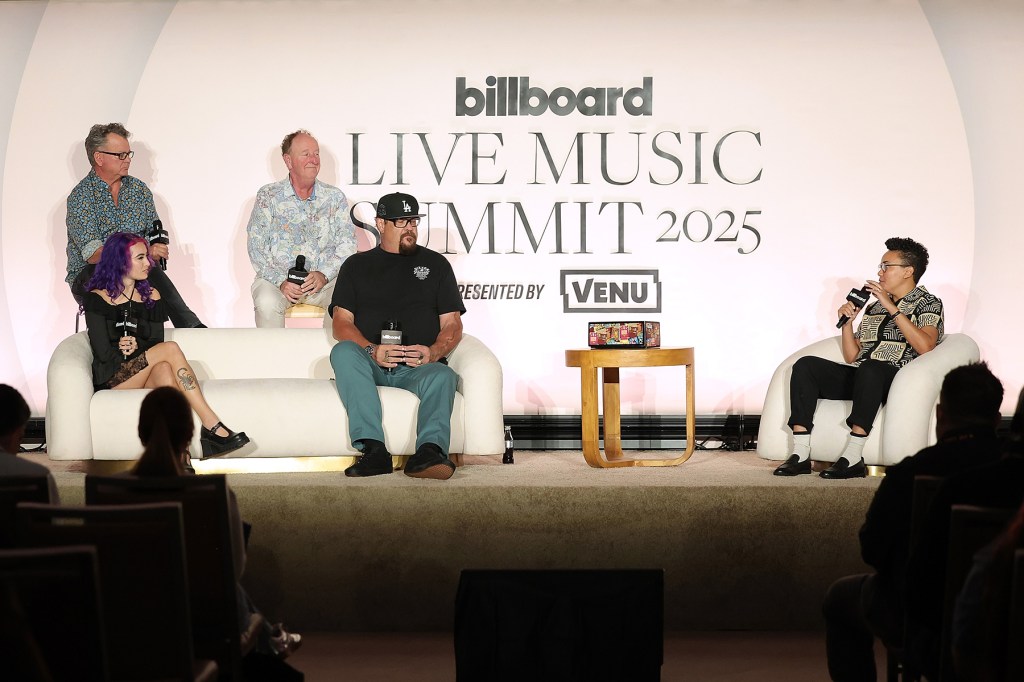
Trending on Billboard
When Warped Tour kicked off in 1995, we’re guessing founder Kevin Lyman didn’t have any idea he’d be mounting a 30th-anniversary edition of his traveling rock fest in 2025 — or that he’d be named Billboard‘s 2025 Visionary at Monday’s (Nov. 3) Billboard Live Music Summit for all the ways he’s helped revolutionize the industry. In fact, he joked onstage that he thought he’d be receiving a different honor: “When you called, I thought it was maybe the ’64 Under 65′ now, and I finally made the list.”
During a panel titled “How Warped Tour Built A Lasting Legacy – And Returned In 2025” at West Hollywood, California’s, 1 Hotel, Lyman was joined by Steve Van Doren, an executive from the tour’s presenting sponsor Vans, as well as Warped vet Fletcher Dragge from the SoCal punk band Pennywise and first-time performer-but-longtime attendee Devin Papdol from L.A. pop-rock band Honey Revenge for a conversation moderated by Billboard editor Taylor Mims.
Below, find the best quotes from each panelist about what makes Warped Tour so special and how it’s evolved across three decades.
Warped Tour founder Kevin Lyman
It was always about trying to get people out to their first festival. You know, having the show end by sunset was a big part of it too. Because to me, 90% of the problems were caused by 10% of the people under cover of darkness at shows. So if we could bring it into the sunshine, we eliminated some of the problems we had, maybe of certain things in punk rock, but it gave people a chance to listen to the music and really observe. … Everything we did from the reverse daycare center [letting parents attend for free in a “Parents’ tent” so teens could attend], all these things I developed were how to get these young people turned on to this music at a younger age, so they can stay with us. I always said they stayed with us until they were 19, and then they wanted to go to a festival and burn up their student loans and do modeling in the desert.
Vans’ Steve Van Doren
I wanted to get skateboarding from Florida, Texas and California to the rest of the country. He [Lyman] wanted to get music in the rest of the country, 35 to 45 stops each year. I thought it’d be perfect. And no room for rock stars — learned that one early. Everybody’s treated the same. Being able to meet [Pennywise’s] Fletcher in the early days, where he invited me over to the barbecue area, and that’s where you get to meet everybody. Everybody’s done at 8:30, 9 o’clock at night. The buses aren’t leaving until 11 o’clock or 11:30, so everybody’s hungry, come back there. And every day is a little bit different.
Pennywise’s Fletcher Dragge
I never went to summer camp, but it was the best summer camp on the planet. So why wouldn’t you go do what you love to do: play music and hang out with the coolest people and do the coolest sh–? Kevin and these guys would always arrange off days, like river trips or wherever you were, and everyone would come, like, all crew, all bands. It was just completely, undeniably some of the best times of my life. So it was like a no-brainer. “You want to come?” Yes. Ten years later: “Now you want to come?” Yes.
Honey Revenge’s Devin Papadol
I went to my first Warped Tour in 2013 and it was kind of the first opportunity for me to be around so many people that liked the same music as me. … Going to Warped opened up this incredible community that I didn’t know was real locally to me; it kind of felt far away until I went. And I went every year until it stopped. … It was how I found all of the music I ended up listening to, and all the music that ended up influencing Honey Revenge.
Trending on Billboard
Rauw Alejandro took a day off between stops on his Cosa Nuestra tour to attend the 2025 Billboard Live Music Summit in Los Angeles to explain how a new partnership with Live Nation helped him create a theatrical spectacle that could “travel through the whole world.”
Alejandro — who came straight from a Sunday (Nov. 2) show in Monterrey, Mexico and has to fly right back for a Tuesday (Nov. 4) performance in Mexico City — took the stage for a spotlight conversation with Billboard’s Leila Cobo and Live Nation senior vp of global touring Hans Schafer at the 1 Hotel West Hollywood on Monday (Nov. 3).
Related
The Cosa Nuestra tour is a high-concept, 1970s New York-inspired spectacle supporting Alejandro’s 2024 album of the same name, which hit No. 6 on the Billboard 200. The tour grossed $91.7 million across spring and summer legs in North America and Europe before heading to South America and Mexico. Alejandro will conclude at the end of this month with a five-date residency at San Juan’s Coliseo de Puerto Rico José Miguel Agrelot.
During the discussion, the cover star of Billboard’s touring issue explained that after attending live theater in New York, he was inspired to create what he called “the biggest Broadway show on earth” — though it’s not so easy to bring Broadway to an arena. Enter Live Nation.
“I consider myself the best, so I want to work with the best team,” said Alejandro of joining up with the concert giant for the tour.
As Alejandro explained, Live Nation helped him bring his vision to life using maximum precision. “We could sell stadiums,” said Alejandro, but ultimately, he and his team decided to schedule his tour in arenas to “focus on the art.” The tour also eschewed outdoor venues, preferring the dark environment of an indoor arena to better evoke the feel of a Broadway theater.
Related
A huge priority, said Alejandro, was to create consistency across markets. As he put it, he didn’t want South American fans to watch one version of Cosa Nuestra on TikTok during the U.S. leg and then be disappointed when a different show came to their cities.
“I had to find a show that I can take everywhere, because I think my fans deserve the best of me,” said Alejandro. “For me, it was really important to put our minds together and find this perfect show that I can travel through the whole world, and I think we did it.”
Schafer, who runs Latin touring for Live Nation, said he was galvanized by Alejandro’s desire to prioritize performance quality over all else.
“The greatest is when you partner with an artist team and they are not looking to make it the biggest, they are looking to make it matter,” said Schafer.
Monday’s panel also covered the way Alejandro was inspired by salsa music for Cosa Nuestra and how he stays in shape for the demanding, dance-heavy show. He said he eats clean — “salmon, white rice, vegetables” — works out and doesn’t drink or smoke on show days.
Alejandro also hinted at what’s next for his touring career. The reggaeton star said he does intend to play stadiums — and that in the future, he aims to take his shows to even more markets than he did this time around. “We want to conquer Asia,” he said.

 State Champ Radio
State Champ Radio 